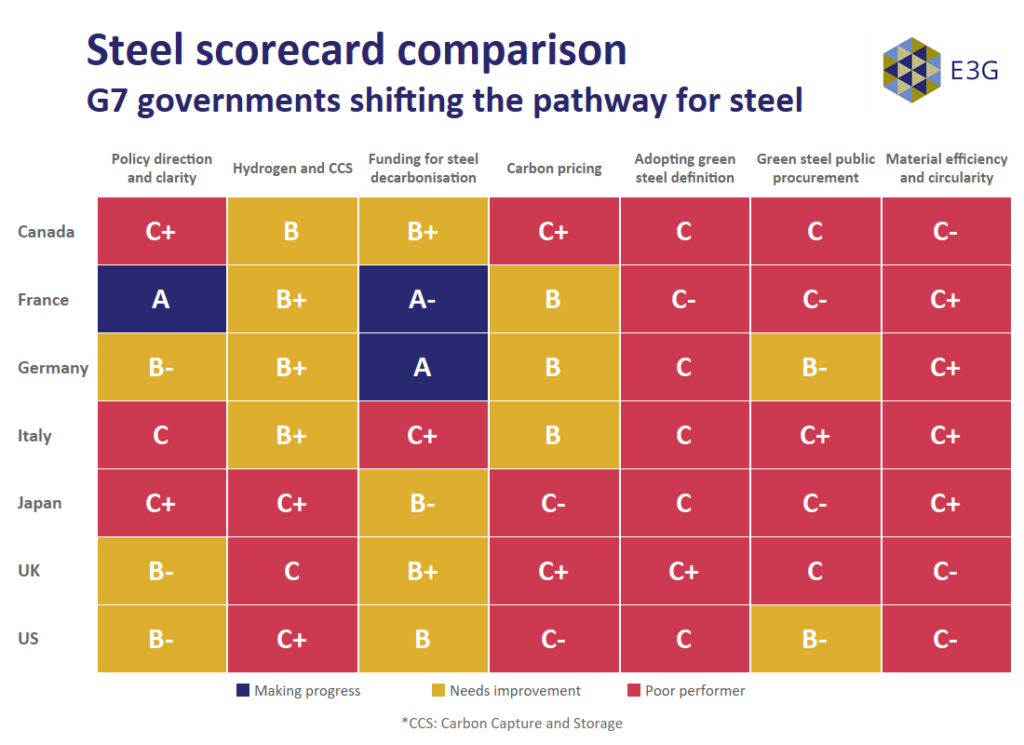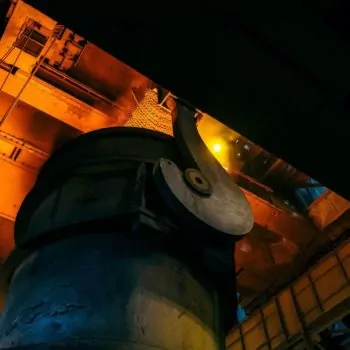The new G7 Steel Policy Scorecard helps keep tabs on policies targeting steel decarbonisation. The briefing provides key policy recommendations on the way forward for G7 countries.
Steel is one of modern society’s most central yet dirtiest building blocks. G7 countries have the ability and the collective responsibility to initiate a shift towards steel decarbonisation. Yet, they are generally far from doing so.
This briefing introduces E3G’s G7 Steel Policy Scorecard. This is a first step in developing a methodology to evaluate government action on steel decarbonisation. Over time, we will be able to track and compare progress. The methodology brings together seven key policy levers that governments can apply to reduce emissions from steel. We use these levers to benchmark government action toward steel transition.
The need for government policy is evident. Corporate emission reduction targets across G7 countries are currently taking us to a global average temperature increase of 2.7 °C.
In this first analysis, we find that the large machineries of the G7 countries are starting to make movements in the right direction. Germany and France are amongst the most ambitious early movers. However, much more needs to happen.
The G7 Steel Policy Scorecard

Click here to view the scorecard on Tableau.
The scorecard shows how the G7 governments fare across seven steel policy levers identified as key enablers for steel decarbonisation. None of the countries are showing concerted government action on all levers. We see the greatest headway on policy direction and clarity, the rollout of hydrogen and carbon capture and storage (CCS), and on government funding for steel decarbonisation.
The G7 countries are exploring the adoption of a green steel definition and green steel public procurement targets. These intentions need to turn into action. Movements on material efficiency and circularity remain largely absent.
Key recommendations:
- G7 governments should all ensure that they have clear and binding emission reduction targets for industry. They must set steel-specific goals and phase-out commitments – such as no new unabated coal-based steel plants after a certain year. They need to steer hydrogen policy towards green hydrogen for steel, while maintaining a steady flow of funding to complement commitments made by the industry itself.
- It is increasingly evident that the US will not take the carbon pricing route, which means it needs to be more ambitious on other policy levers. We urge Canada and Japan to look at strengthening their respective mechanisms and closing industrial loopholes. The EU countries – France, Italy and Germany – must now play a progressive role in ongoing negotiations on EU climate policy, ensuring that clear and ambitious phase-out dates for free allowances are legislated in the context of its Emissions Trading System (ETS). The UK should duly follow such a lead, within its own ETS.
- G7 countries need to turn intention into action and formally adopt an internationally aligned green steel definition, with an agreed emissions intensity threshold and a measurement standard. Dovetailing this, the US, UK, Canada and Germany should move swiftly on their stated intentions for green steel public procurement targets and requirements, with the other G7 countries swiftly picking up the baton and following suit.
- Finally, there is a need to reduce the demand for steel and increase steel reuse and recycling. All G7 countries need to move beyond mentioning the importance of circularity and efficient use of steel, to setting clear and coherent targets and actions. These will then need to be mainstreamed into the various policy and regulatory spaces affected – from building codes to product design requirements and regulation on reuse and recycling.


